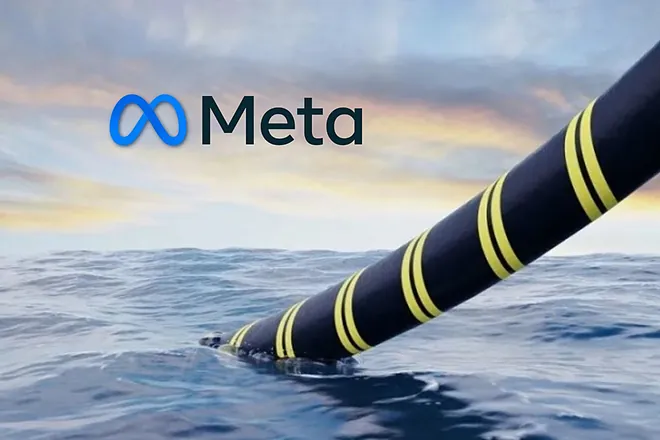What’s Behind Meta’s Massive Undersea Cable Project?
- Meta confirms Project Waterworth, a 50,000-kilometer subsea cable. This will be the world’s longest undersea network.
- The project spans five continents, linking key regions, including the U.S., Brazil, India, and South Africa.
- AI and digital growth drive the investment, supporting cloud services and faster online connectivity.
- India plays a crucial role, backing the project financially while enhancing Indian Ocean connectivity.
Meta’s Ambitious Plan to Connect the World
Meta, the parent company of Facebook, Instagram, and WhatsApp, has officially announced its groundbreaking ‘Project Waterworth.’ This $10 billion subsea cable project will span 50,000 kilometers, making it the longest of its kind in the world. The cable will connect five continents, including key regions like the United States, Brazil, India, and South Africa. Meta aims to enhance global connectivity, particularly for AI services and digital communication, while gaining more control over its infrastructure.
The project is a significant step forward in Meta’s strategy to reduce reliance on third-party networks. By owning and operating its own subsea cable, Meta can ensure faster, more reliable connections for its billions of users. This is especially important as the company continues to expand its AI-driven services, which require massive amounts of data to function effectively.
Check Out Similar Article of Starlink to Launch in Pakistan by June – What This Means for Internet Users Published on February 5, 2025 SquaredTech
Why India is Central to Meta’s VisioAn
India, the world’s most populous country, plays a pivotal role in Meta’s strategy. The subsea cable will support the growth of AI data centers and cloud services in the region. Meta’s VP of engineering, Gaya Nagarajan, emphasized that the project will enable digital communication, video experiences, and online transactions.
India’s involvement goes beyond just being a landing point for the cable. The country has committed to investing in the maintenance and financing of undersea cables in the Indian Ocean. This partnership highlights India’s growing importance in the global tech landscape and its commitment to improving digital infrastructure.
Innovative Technology Behind the Project
Meta is pushing the boundaries of subsea cable technology with its 24-fiber pair cables and advanced routing techniques. The cable will be laid at depths of up to 7,000 meters, with new burial methods to minimize faults in high-risk areas. This innovative approach ensures reliability and efficiency, addressing both geographical and political challenges.
The use of 24-fiber pair cables is a game-changer. These cables can carry significantly more data than traditional ones, ensuring that Meta’s network can handle the increasing demand for high-speed internet. Additionally, the new burial techniques reduce the risk of damage from natural disasters or human activities, making the network more resilient.
Meta Joins the Big Tech Subsea Race
While Meta has previously collaborated on subsea cable projects, ‘Project Waterworth’ marks its first wholly owned venture. This move places Meta alongside tech giants like Google, Amazon, and Microsoft, who are also investing heavily in undersea infrastructure. According to telecom analysts TeleGeography, Meta currently co-owns 16 existing networks, including the 2Africa cable.
Google, for example, is involved in 33 different subsea cable routes, some of which it owns entirely. Amazon and Microsoft, on the other hand, are major capacity buyers in these projects. Meta’s decision to build its own cable reflects a broader trend among tech companies to control more of their infrastructure, ensuring better performance and security for their services.
Geopolitical Factors Influencing the Project
Geopolitics has played a significant role in Meta’s decision to build its own subsea cable. The recent joint statement from U.S. President Trump and India’s Prime Minister Narendra Modi highlighted the importance of undersea technologies in strengthening defense partnerships. The statement also mentioned Meta’s ‘Project Waterworth,’ emphasizing India’s role in financing and maintaining undersea cables in the Indian Ocean.
This geopolitical backing not only provides financial support but also ensures that the project can navigate the complex political landscape of international telecommunications. By aligning with key governments, Meta can mitigate risks and ensure the successful completion of its ambitious project.
The Future of Global Connectivity
‘Project Waterworth’ is more than just a subsea cable; it’s a vision for the future of global connectivity. By connecting five continents, Meta is laying the groundwork for a more interconnected world. This project will enable faster internet speeds, more reliable connections, and new opportunities for innovation in AI and digital services.
As the world becomes increasingly digital, the importance of robust and reliable internet infrastructure cannot be overstated. Meta’s investment in ‘Project Waterworth’ is a testament to the company’s commitment to leading the way in this new era of global connectivity.
Stay Updated: Tech News


